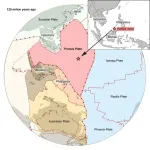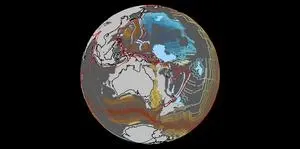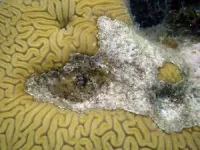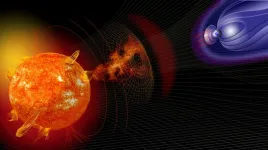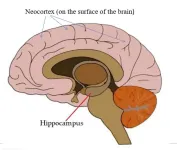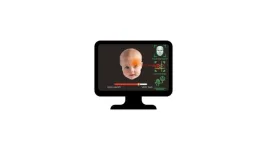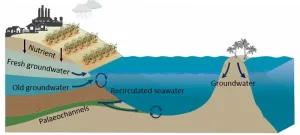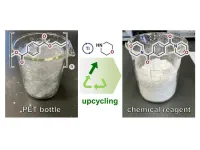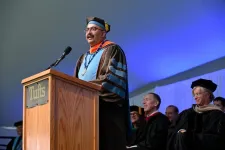(Press-News.org) Utrecht University geologist Suzanna van de Lagemaat has reconstructed a massive and previously unknown tectonic plate that was once one-quarter the size of the Pacific Ocean. Her colleagues in Utrecht had predicted its existence over 10 years ago based on fragments of old tectonic plates found deep in the Earth’s mantle. Van de Lagemaat reconstructed lost plates through field research and detailed investigations of the mountain belts of Japan, Borneo, the Philippines, New Guinea, and New Zealand. To her surprise, she found that oceanic remnants on northern Borneo must have belonged to the long-suspected plate, which scientists have named Pontus. She has now reconstructed the entire plate in its full glory. Suzanna van de Lagemaat will defend her dissertation on this plate tectonics puzzle at Utrecht University on Friday, October 13.
Understanding the movements of the tectonic plates that make up the earth’s rigid outer shell is essential to understand the planet’s geological history. The movements of these plates strongly influenced how the planet’s paleogeography and climate have changed over time, and even where to find rare metals. But large oceanic plates from the geological past have since disappeared into the earth’s mantle by means of subduction. They have left behind only fragments of rock hidden in mountain belts. Van de Lagemaat studied the planet’s most complicated plate tectonic region: the area around the Philippines. “The Philippines is located at a complex junction of different plate systems. The region almost entirely consists of oceanic crust, but some pieces are raised above sea level, and show rocks of very different ages.”
Reconstruction
Using geological data, Van de Lagemaat first reconstructed the movements of the current plates in the region between Japan and New Zealand. That revealed how large the area was of plates that must have disappeared in the current western Pacific region. “We also conducted field work on northern Borneo, where we found the most important piece of the puzzle. We thought we were dealing with relicts of a lost plate that we already knew about. But our magnetic lab research on those rocks indicated that our finds were originally from much farther north, and had to be remnants of a different, previously unknown plate.” But the important realisation was yet to come. “11 years ago, we thought that the remnants of Pontus might lie in northern Japan, but we’d since refuted that theory”, explains Douwe van Hinsbergen, Van de Lagemaat’s PhD supervisor. “It was only after Suzanna had systematically reconstructed half of the ‘Ring of Fire’ mountain belts from Japan, through New Guinea, to New Zealand that the proposed Pontus plate revealed itself, and it included the rocks we studied on Borneo.”
Relics
The relics of Pontus are not only located on northern Borneo, but also on Palawan, an island in the Western Philippines, and in the South China Sea. Van de Lagemaat’s research also showed that a single coherent plate tectonic system stretched from southern Japan to New Zealand, and it must have existed for at least 150 million years. That is also a new discovery in the field.
Waves
The previous predictions of the existence of Pontus were made possible because a subducted plate leaves behind traces when it ‘sinks’ into the earth’s mantle: zones in the mantle with anomalous temperatures or compositions. These anomalies can be observed when seismographs pick up signals from earthquakes. Earthquakes send waves through Earth’s interior, and when they travel through an anomaly, such as a fragment from an old plate, the anomaly produces a disruption of the signal. Geologists can trace these disruptions to the existence of phenomena in the mantle, such as fragments of tectonic plates. That allows them to look 300 million years into the past; older plate fragments have ‘dissolved’ at the boundary between the mantle and the core. The study from 11 years ago showed that a large subduction zone must have run through the western paleo-Pacific Ocean, which separated the known Pacific plates in the east from the hypothetical Pontus plate in the west. This hypothesis has now been independently demonstrated by Van de Lagemaat’s research.
Article
Van de Lagemaat, S.H.A., & van Hinsbergen, D.J.J., 2023, ‘Plate tectonic cross-roads: Reconstructing the Panthalassa-Neotethys Junction Region from Philippine Sea Plate and Australasian oceans and orogens’, Gondwana Research, https://www.sciencedirect.com/science/article/pii/S1342937X23002617
The study from 11 years ago: Van der Meer, D.G., Torsvik, T.H., Spakman, W., van Hinsbergen, D.J.J., & Amaru, M.L., 2012, ‘Intra-Panthalassa Ocean subduction zones revealed by fossil arcs and mantle structure’, Nature Geoscience 5, 215-219: https://www.nature.com/articles/ngeo1401
END
Plate tectonic surprise: Utrecht geologist unexpectedly finds remnants of a lost mega-plate
2023-10-09
ELSE PRESS RELEASES FROM THIS DATE:
Researchers identify largest ever solar storm in ancient 14,300-year-old tree rings
2023-10-09
An international team of scientists have discovered a huge spike in radiocarbon levels 14,300 years ago by analysing ancient tree-rings found in the French Alps.
The radiocarbon spike was caused by a massive solar storm, the biggest ever identified.
A similar solar storm today would be catastrophic for modern technological society – potentially wiping out telecommunications and satellite systems, causing massive electricity grid blackouts, and costing us billions of pounds.
The academics are warning of the importance ...
Should a more individualized model replace the current method for determining which people should be screened for lung cancer?
2023-10-09
A new study found that an alternative model to identify patients with lung cancer eligible for screening was more accurate than the currently used method based on the United States Preventive Services Task Force (USPSTF) criteria. The results are published by Wiley online in CANCER, a peer-reviewed journal of the American Cancer Society.
Lung cancer is the leading cause of cancer deaths, and using low-dose computed tomography scans to screen people who are at elevated risk for lung cancer reduces lung cancer deaths. The USPSTF criteria use age and smoking history to determine ...
Is this how antidepressants work, and why they take weeks to kick-in?
2023-10-09
Type of work: peer-reviewed/randomised controlled trial/people
SSRI antidepressants normally take a few weeks before any showing mental health benefits, but how come it takes so long? Now a study from a group of clinicians and scientists provides the first human evidence that this is due to physical changes in the brain leading to greater brain plasticity developing over the first few weeks of SSRI intake. This may also begin to explain one of the mechanisms of how antidepressants work.
This work is presented at the ECNP conference in Barcelona on 9th October. This ...
Teaching expectant mothers to bond with their babies
2023-10-09
Type of work: Peer-reviewed / experimental study / people
Up to a third of mothers don’t bond well with their babies after birth, causing intense emotional distress to both mother and baby1. Now researchers have found that they can train at-risk expectant mothers to recognise and regulate emotions better, potentially reducing their risk of postpartum depression.
Presenting the work at the ECNP Congress in Barcelona, researcher Dr Anne Bjertrup said:
People generally have an automatic tendency to see the positive or negative in any situation. In previous studies we saw that certain ...
Young children who are close to their parents are more likely to grow up kind, helpful and ‘prosocial’
2023-10-09
A loving bond between parents and their children early in life significantly increases the child’s tendency to be ‘prosocial’, and act with kindness and empathy towards others, research indicates.
The University of Cambridge study used data from more than 10,000 people born between 2000 and 2002 to understand the long-term interplay between our early relationships with our parents, prosociality and mental health. It is one of the first studies to look at how these characteristics interact over a long period spanning childhood and adolescence.
The researchers ...
The hidden scars: Stigmatization a major impact of skin diseases across Europe
2023-10-09
(Lugano, Monday, 9 October 2023) A major pan-European study has revealed that almost all patients affected by skin diseases face embarrassment, with the psychological burden compounding the physical impact of living with the disease.1,2
The Burden of Skin Disease in Europe, published today in the Journal of the European Academy of Dermatology and Venereology (JEADV), analysed 19,015 individuals with a range of skin diseases and revealed the huge psychological toll of living with a disease. The diseases examined included, amongst others, fungal skin infections, acne, atopic dermatitis (eczema), alopecia, psoriasis and sexually transmitted diseases (STDs).
With high levels of stigmatisation, ...
Discovery of invisible nutrient discharge on Great Barrier Reef raises concerns
2023-10-08
Scientists using natural tracers off Queensland’s coast have discovered the source of previously unquantified nitrogen and phosphorous having a profound environmental impact on the Great Barrier Reef.
The findings, published today in Environmental Science and Technology, indicate current efforts to preserve and restore the health of the Reef may require a new perspective.
Southern Cross University’s Dr Douglas Tait leads the ground-breaking study, ‘Submarine groundwater discharge exceeds river inputs as a source of nutrients to the Great Barrier Reef’.
Submarine ...
Scientists upcycle polyesters through new waste-free, scalable process
2023-10-07
Tokyo, Japan – Researchers from Tokyo Metropolitan University have developed a new chemical process which upcycles polyesters, including PET in plastic bottles, to morpholine amide, a versatile and valuable building block for synthesizing a vast range of compounds. The reaction is high yield, waste-free, does not require harmful chemicals, and is easily scalable. The team successfully break the often costly closed-loop recycling loop of plastic waste, allowing upcycling to more valuable products.
Recycling plays an indispensable part of our fight against plastic waste. But at what ...
Tufts University president Sunil Kumar aims to spread the light beyond the hill
2023-10-07
Under overcast skies that stood no chance of clouding the celebratory tone of the day, hundreds of faculty, staff, students, alumni, neighbors, and academic leaders gathered today on the Medford/Somerville campus to witness the inauguration of Sunil Kumar as the 14th president of Tufts University. He succeeds Anthony P. Monaco, who served as president for 12 years.
Delegates from more than 85 academic institutions and learned societies around the world attended Kumar’s inauguration ceremony on the residential quad. The ceremony ...
Antidepressants versus running for depression: is there a winner?
2023-10-07
Type of work: peer-reviewed/experimental study/people
The first study to compare effects of antidepressants with running exercises for anxiety, depression and overall health shows that they have about the same benefits for mental health – but a 16-week course of running over the same period scores higher in terms of physical health improvement, whereas antidepressants lead to a slightly worse physical condition, as has been suggested by previous studies. However, the drop-out rate was much higher in the group which initially ...
